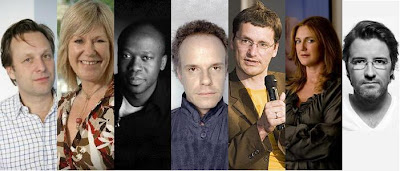
To promote dialogues between art and the surroundings, is to take initiative and reach out to the public instead of waiting to be appreciated there. On one hand, this kind of art space invites visitors to the atmosphere of art in various ways, and even willing to be changed by it's visitors and surroundings; on the other hand, it delivers and "implants" sense of art into the surrounding environment.
Objects that art spaces talk to include visitors, passersby, the community, natural environment and cultural context.
Approaches of these dialogues include:
Movement of art space itself — shifting from one spacial context to another
● CHANEL Mobile Art Pavilion
● Nomadic Museum
Temporary exhibition spaces — interpose art into the surroundings and become a public temptation
● The Serpentine Gallery Pavilions
Architecture as art work itself — deep corporation between artists and architects, blending art, architecture and nature
● Your Black Horizon Art Pavilion
新媒体艺术、大地艺术、行为艺术...... 当代艺术正在 试图重新接近大众,通过强调和发展它的互动性和公共性,努力融入到我们的生存环境之中。相应地,艺术空间也完全有理由从陈放艺术品的容器转变为推动艺术与周围环境之间产生对话的媒介。
艺术空间与周围环境的对话,就是改静态地被欣赏为主动出击,一方面用各种方式把参观者引入到艺术的场域,甚至主动被前来参观的人和周围的环境所改变;另一方面它又实现了一种自我输出,把艺术的气息植入、扩散到周遭的环境。
艺术空间所对话的对象包括前来参观者、路人、周边社区、所处的自然环境、乃至文化语境。
艺术空间与周围环境对话的形式包括:
自身的移动 —— 直接游移于不同的空间环境
● Zaha Hadid设计的CHANEL移动艺术馆是当下的典型例子。这是一个飘洋过海来见你的艺术馆。
● 艺术家Gregory Colbert与不同建筑师合作了Nomadic Museum,期望通过这个艺术馆在全世界的游牧,让他的艺术理想与不同文化产生更丰富的交流。
临时性的展示空间 —— 介入周围环境,造成短期聚集效应
● Serpentine Gallery 每年都会请一位建筑大师在公园中做一个Pavilion(临时展厅),和其他项目一起,这家画廊每年吸引约750,000 位参观者。
建筑本身作为艺术品 —— 艺术与环境更直接的对话,作品同时往往也能移动
● Your Black Horizon:艺术家与建筑师的合作项目,将艺术、建筑、自然融为一体。
这些主动与环境对话的艺术空间给我们带来的是一改以往祭坛一般的博物馆、千篇一律的画廊白盒子模式的新面貌,用一种极为开放的姿态推进和提升我们的艺术氛围,刺激城市的脑细胞,乃至改善我们的生存环境。而这,本身就是一种艺术。

These spaces can be regarded as pavilions as well. Pavilions are temporary structures with an open attitude and a potential to move, they are great alternatives for art spaces to improve it's interaction with the surroundings nowadays. In 2006, a panel discussion on the topic of "pavilion" was held with a group of leading figures in contemporary art in Venice. Here is an abridged edition of the discussion:
这些空间同时都可以看作为Pavilion。Pavilion这个词的意思比较宽泛,中文可以翻译成帐篷、亭子、临建馆、临时展厅等,一般是临时建筑物。它具有临时性、潜在的移动性和开放性等特质。Pavilion是当前促进艺术与人和环境对话的一种非常好的空间形式,发展前途也非常宽广。2006年在威尼斯,一组当代知名艺术家、建筑师、策展人、学者和赞助人对此进行了一次非常有意义的研讨和探索。我选取了这段对话中的精彩片断,在此与大家分享 :
Daniel Birnbaum (Städelschule Art Academy Director and Professor): Welcome, everybody. I would like to start with a very general question to the panelists to see what they find interesting about pavilions. Maybe Jude could say a little bit about what pavilions mean?
Jude Kelly (Artistic Director, Southbank Centre, London): I believe that cultural palaces need to continually dissolve because they’re only containers, and actually it’s the ideas inside, bursting forward, that are most relevant. There’s something about temporary pavilions that can be joyful and interesting, and I think this is something you should pursue.
David Adjaye (Architect): Traditionally, pavilions have been used in landscapes. In the twentieth century, there was a precedent of pavilions being used to promote lots of things, including nations.
Hans-Ulrich Obrist (Co-Director, Serpentine Gallery, London): Another aspect of pavilions, which is very fascinating, is the idea of their limited life span, something the late Cedric Price always talked about. He was applying this idea to buildings and also to books, insisting that they should have a limited life span. In this sense, the pavilion allows a form of experimentation, which perhaps a permanent building doesn’t.
Andreas Ruby (Architecture critic and theorist): It is initiative to provide an alternative to the museum as the generic space for the experience of art. The pavilion is a very interesting choice, precisely because it is not really a house. If I am not mistaken, its etymological origin is the word papillon, French for butterfly, and if we think about the life cycle of the butterfly, we remember that at some point it was not a butterfly but a cocoon. For me, architecture is the cocoon, and the pavilion helps to transgress this very clear boundary between the little animal inside the cocoon and the world outside. This dialectic harbors a great potential for a project that aims to create different modes of relationship between art and the viewer than the museum or other established art exhibition setups do.
Francesca von Habsburg (Chairman, Thyssen-Bornemisza Art Contemporary, Vienna): I think that the traditional layout of the museums that I visit on a regular basis, this room-to-room encyclopedic approach to exhibiting, is not at all suited to the type of artworks that I am interested in. Again, that produced another challenge, and I’m asking myself a great deal of questions, integrating personal passions such as landscape, view, the environment that we live in, whether it be urban or the middle of Patagonia, or here by the side of the lagoon in Venice. Incorporating the light, the place, the sounds, the water, you enter the pavilion but can still hear the water lapping against the façade of the island. I like integrating all of these elements into one piece.
Olafur Eliasson (Artist): Furthermore, I think the Guggenheim story has proven to have been a nineties phenomenon; the Bilbao story doesn’t seem to work anymore. I can imagine hundreds of cities like Bilbao having already asked Guggenheim and wanting to repeat the success. I think we are in a different situation in which the brand economy is not just the one that Guggenheim represents. There is an issue of responsibility: if you want to present a work of art, you need to allow that work of art to be in front of the brand.
Daniel Birnbaum (德国法兰克福市立艺术大学校长兼教授):欢迎大家。首先我想问问各位主讲人一个非常宽泛的问题,大家为什么认为Pavilion很有意思。
Jude Kelly (伦敦南岸中心艺术总监):我认为那些文化殿堂只是一种载体,需要逐步地退出文化界,而且实际上它内部喷涌的内涵才是最具实质意义的。那些临时建筑设计可能会更令人愉快、更有趣,我想这也是你们应该继续推行的。
David Adjaye (建筑师):Pavilion在传统意义上是一种风景摆设。到了20世纪,有人开始利用Pavilion来宣传很多事物,包括国家。
Hans-Ulrich Obrist (联合策展总监和国际项目总监,伦敦蛇形画廊):Pavilion的另外一个吸引人的特征是它有限生命跨度的理念。这是已故的Cedric Price经常提到的。他生前一直将这个理念运用到建筑和书本上,坚持认为他们应该有一个有限的生命跨度。在这样的意义下,Pavilion极富实验性,或许这是永久性的建筑所做不到的。
Andreas Ruby (建筑评论家和理论工作者):提供一个有别于博物馆的普通空间去体味艺术是新的方向,其中Pavilion变成了一个很有趣的选择。具体点说因为它不是一座真正的房子。如果我没弄错,Pavilion这个词的词源是法语的“蝴蝶”(Papillon)。如果我们联想一下蝴蝶的生命周期,那么我们便会发现它在某一阶段不是一只蝴蝶而是一个茧。对我来说,建筑物就是一个茧,而Pavilion可以帮助它去跨域茧中幼小的生命和外面世界之间的这条清晰的界限。这个辩证法隐匿了一股巨大的潜力,旨在建立艺术和观众之间的关系,形式不同于博物馆或是其他既成艺术展览馆。
Francesca von Habsburg (维也纳Thyssen-Bornemisza基金会主席):我认为博物馆传统布局的那种房间挨房间的如百科辞典般的展览方法,完全不适合我所感兴趣的艺术作品类型。所以,这又提出了新的挑战。我总问自己很多问题,关于人性情感的统一性,就像我们居住在的风景、视野和环境里,无论那是在郊区还是在巴塔哥尼亚(南美一地区)中部,还是现在我们所处的威尼斯的湖边。将光线、地点、声音、水融为一体,你进入Pavilion但仍然能听到水拍打在岛礁上的声音。我喜欢将很多事物融合成一个整体。
Olafur Eliasson (艺术家):另外,我认为古根海姆(Guggenheim)的故事是九十年代的现象;毕尔巴鄂(Bilbao)的故事似乎不再有用了。我可以想象到有成百上千的像毕尔巴鄂这样的城市想要复写当年的辉煌。我认为我们并不处在古根海姆代表的简单品牌经济那个年代。这里有个责任的问题:如果你想要推出一件艺术作品,你需要让艺术作品置于品牌之前。







No comments:
Post a Comment